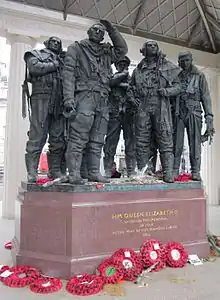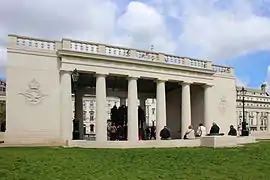RAF Bomber Command Memorial
The Royal Air Force Bomber Command Memorial is a memorial in The Green Park, London, commemorating the crews of RAF Bomber Command who embarked on missions during the Second World War.[1] The memorial, on the south side of Piccadilly, facing Hyde Park Corner, was built to mark the sacrifice of 55,573 aircrew from Britain, Canada, Australia, New Zealand, Poland, Czechoslovakia and other allied countries,[2] as well as civilians of all nations killed during raids.[3]
| RAF Bomber Command Memorial | |
|---|---|
| United Kingdom | |
 Sculpture within the memorial | |
| For the 55,573 aircrew of RAF Bomber Command who died during the Second World War | |
| Unveiled | 28 June 2012 |
| Location | |
| Designed by | Liam O'Connor (memorial) Philip Jackson (sculpture) |
Freedom is the sure possession of those alone who have the courage to defend it | |
Queen Elizabeth II unveiled the memorial on 28 June 2012, the year of her Diamond Jubilee.[4]
History
A strong, deadly use of force in strategic but often imprecise, and heavily counter-defended, bombing campaigns is the subject-matter. The multi-year onslaught hastened the end of the war and thus genocide such as in Nazi extermination camps, but civilian casualties makes the whole issue controversial.[5] At least 353,000 civilians were killed in Germany from bombing, but not as a direct aim of the offensives. The controversy meant that an official memorial to the aircrews was not erected until decades after the war. Despite describing bombers as "the means of victory" in 1940, British prime minister Winston Churchill did not mention Bomber Command in his speech in 1945.[6]

An appeal was made for £5.6 million to build the memorial, and funding came from donations made by the public. Robin Gibb, the singer, became a key figure behind the appeal, working alongside Jim Dooley to raise funds and have the memorial built.[7]
Liam O'Connor designed the memorial, built of Portland stone, which features a bronze 9-foot (2.7 m) sculpture of seven aircrew, designed by the sculptor Philip Jackson to look as though they have just returned from a bombing mission and left their aircraft.[4]
.JPG.webp)
Aluminium from a Royal Canadian Air Force Handley Page Halifax of No. 426 Squadron that had crashed in Belgium in May 1944 was used to build the roof of the memorial, which was designed to evoke the geodetic structure of the Vickers Wellington. The Halifax, LW682 OW/M, had been removed from a swamp in 1997 with three of the crew found still at their posts. They were buried with full military honours in Geraardsbergen and the remains of the aircraft were sent to Canada. Some of the metal was used for the restoration of a Halifax in Trenton, Ontario, and the rest was melted down by the Bomber Command Museum of Canada in Nanton, Alberta. The Museum provided ingots for the memorial to commemorate the 10,659 of 55,573 Bomber Command aircrew killed during the war that were Canadian.[8][9] Furthermore, some of this aluminium was supplied to the International Bomber Command Centre in Lincoln UK and forms the rear plate of the 'Additions Panel'.
On both walls inside the monument there are inscriptions that read: THIS MEMORIAL IS DEDICATED TO THE 55,573 AIRMEN FROM THE UNITED KINGDOM BRITISH COMMONWEALTH & ALLIED NATIONS WHO SERVED IN RAF BOMBER COMMAND & LOST THEIR LIVES OVER THE COURSE OF THE SECOND WORLD WAR and, on the opposite wall: THE FIGHTERS ARE OUR SALVATION BUT THE BOMBERS ALONE PROVIDE THE MEANS OF VICTORY . WINSTON CHURCHILL SEPTEMBER 1940. The inside face of the architrave to the rear of the statues carries the inscription This memorial also commemorates those of all nations who lost their lives in the bombing 1939-1945. The large plinth carrying the statues bears the inscription HM Queen Elisabeth unveiled this monument 28 June in the year of her diamond jubilee. The rear face carries a text by Pericles: Freedom is the sure possession of those alone who have the courage to defend it.[10]
Since opening

There was controversy in the lead-up to the official opening – a lack of forthcoming funds to pay for the projected £700,000 cost of the ceremony. Some veterans pledged money as security, in default of sufficient donations. In October 2012 it was reported that these pledging trustees would likely make up £500,000 of the total.[11]
Queen Elizabeth II officially opened the memorial on 28 June 2012, unveiling the bronze sculpture. The ceremony was attended by 6,000 veterans and family members of those killed,[4] and the Avro Lancaster of the Battle of Britain Memorial Flight dropped red poppy petals over Green Park.[12]
In May 2013 the memorial was vandalised. The word 'Islam' was spray-painted on the memorial and on the Animals in War Memorial in the near part of Hyde Park.[13]
In March 2015, Les Munro, one of the last surviving members of the Dambusters Raid, intended to sell his war medals and flight logbook at auction to raise funds for the upkeep of the memorial. This was cancelled after Lord Ashcroft donated £75,000 to the Royal Air Force Benevolent Fund towards the upkeep, with a further NZ$19,500 donated by the Museum of Transport and Technology in Auckland, New Zealand, where the medals will go on display.[14] Munro died that August.[15]
See also
References
- "Kiwi WWII veterans to attend London memorial". New Zealand Herald. 28 June 2012. Retrieved 28 June 2012.
- "RAF Bomber Command Losses of the Second World War". Retrieved 7 September 2019.
- "The Aircrew of Bomber Command". Royal Air Force Benevolent Fund. 2012. Retrieved 28 June 2012.
- "Queen unveils RAF Bomber Command memorial". BBC News. 28 June 2012. Retrieved 28 June 2012.
- See for example Sanders, Paul, and Keith Grint. "The interplay of the Dirty Hands of British area bombing and the wicked problem of defeating Nazi Germany in the Second World War–A lesson in leadership ethics," Leadership 15, no. 3 (2019): 271-295; Ford, John C. "The morality of obliteration bombing." Theological Studies 5, no. 3 (1944): 261-309.
- Harrison, Paul (28 June 2012). "War Dead From Bomber Command Honoured". Sky News. Retrieved 28 June 2012.
- Barling, Kurt (21 May 2012). "Bee Gees singer Robin Gibb's War Memorial Campaign". BBC News. Retrieved 28 June 2012.
- "Memorial Update No 5". Bomber Command Memorial Appeal. 2012. Retrieved 30 June 2012.
- "Canada's Bomber Command Memorial". Bomber Command Museum of Canada. Retrieved 28 January 2016.
- It is in fact a very loose translation or rather paraphrase taken from the funeral oration that Pericles gives in honour of dead soldiers in the History of the Peloponnesian War, a work by the ancient greek historian Thukydides (book II, chapter 43). The phrase has been widely used on war memorials, already on those commemorating the dead of World War I. Cf. Thukydides Project, University of Bristol
- "Bomber Command veterans face cash shortfall". BBC News. 3 October 2012.
- Sengupta, Kim (28 June 2012). "Memorial to Bomber Command unveiled in Green Park". The Independent. London. Retrieved 28 June 2012.
- "Vandals deface war memorials in London parks". BBC News. 27 May 2013.
- Wilson, Libby (25 March 2015). "Deal keeps Dambuster medals in NZ". The Press. p. A4.
- Thomas, Rachel; Wilson, Libby (4 August 2015). "New Zealand loses a 'remarkable man' with death of Les Munro; John Key says". Stuff.co.nz. Retrieved 4 August 2015.